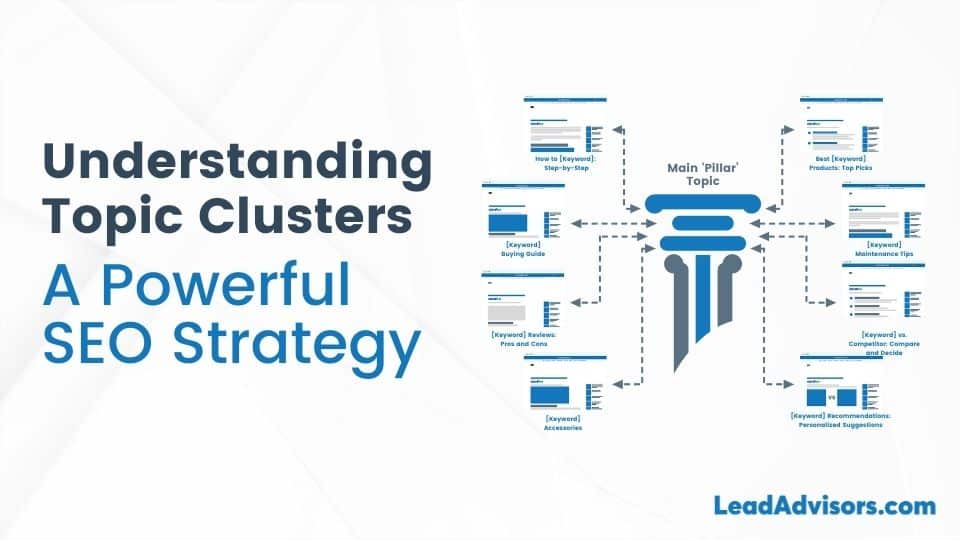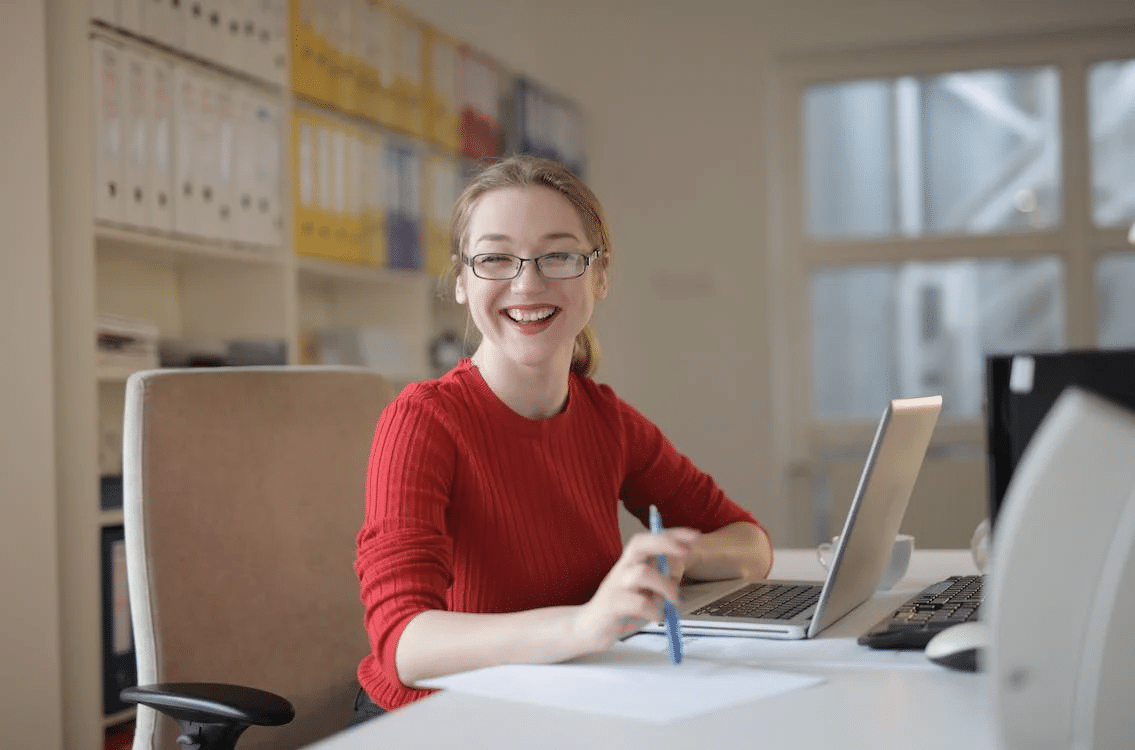Have you ever wondered how some websites or web pages seem to rank for a crazy number of long-tail keywords? Or how can they provide such comprehensive info on certain topics without their content becoming scattered everywhere? The secret sauce they’re using is called “topic clusters.” So now, what are topic clusters?
Since consumers increase their search engine usage by up to 20% each year, topic clusters become a powerful SEO strategy. They help websites rank higher in search and improve the user experience. In this article, I’ll explain what topic clusters are, how to create them, and why they can hugely benefit any website’s organic traffic and visibility.
What Are Topic Clusters?
Simply put, a topic cluster is a group of closely related content centered around a main “pillar” topic. This pillar content dives deep into the primary subject matter.
It then has various “subtopics” branching off from it that cover additional aspects, depths, or angles of the overarching theme. Imagine a topic cluster about dogs.
The pillar page could be about “choosing the perfect dog breed.” Then, some related subtopics would include pages for “dog grooming,” “dog training,” “dog nutrition,” and so on. All the content is interconnected and complementary.
This clustering helps search engines understand the full context and scope of the information you provide on a subject. It shows in-depth coverage available and prevents topics from being siloed off independently.
Topic clusters allow sites to rank under an overarching keyword theme for many specific queries.
How to Create Topic Clusters
Creating effective topic clusters requires proper planning and execution. Here are the basic steps to develop effective topic clusters:
- Research and select a topic, theme, or keyword with enough search volume and interest from target users. Identify higher search engine rankings, high-intent themes, and competitive keywords related to your industry or business goals.
- You can also utilize keyword research tools such as Ahrefs, SurferSEO, SEMRush, etc, to evaluate search rankings, demands, and keyword difficulties. Make sure to check top-ranking pages for popular questions and considerations.
For additional SEO efficiency, you can explore some of the best SEO Chrome extensions that streamline keyword and competitor research. - Create an in-depth pillar page that establishes domain expertise on the core subject using visuals, structured data, and internal linking. Incorporate headers, images, videos, and structured data as applicable.
- Brainstorm related subtopics and map them to the pillar. Keywords, keyword phrases, questions, and variations on the overarching theme make good subtopics. Filter the ideas to only the most applicable and queried variations.
- Write unique, high-quality content for all subtopic pages while cross-linking them under the pillar for a cohesive experience and cross-linking related content clusters under the umbrella of the pillar topic.
- Continuously update, optimize, and expand the clusters by adding new pages and refining old content. Monitor performance and feedback to prioritize enhancement efforts.
Benefits of Using Topic Clusters
Topic clusters provide several fundamental benefits for SEO or search engine optimization and the user experience. Some key advantages of employing topic clusters include:
- Increased relevance to search engines by providing thorough multi-angle topic coverage. It demonstrates deep expertise on a topic. Related subtopics strengthen topical authority in search results.
- Improved user experience with complementary information grouped cohesively. Users can easily find related keywords and comprehensive information in one place. Cohesive navigation guides readers through the ecosystem of a topic.
- Expanded organic reach and ability to target long-tail keywords related to the cluster’s unifying theme. Cluster pages can target long-tail search queries. Increased opportunities to rank for multiple keywords, especially with strategies like how to rank in AI overviews that enhance modern visibility.
- Stronger on-page optimization by internally linking associated pages under a parent topic. Internal links pass relevance and trust between pages, while semantically aligned architecture cues search engines.
- An ever-evolving framework to continually develop new relevant content and stay up-to-date. Adapts to emerging questions, industry changes, and updates.
Best Practices for Optimization
Ongoing refinement and optimization are essential to maximize the benefits of topic clusters. Some best practices for refining clusters include:
- Technical SEO- On-page SEO tweaks like headings, word count, speed, and structured data for pillar and subtopic pages. Improve site speed and performance for all pages. Also, you can add schema markup, images, and other rich snippets, and regularly test and update meta descriptions. Strong technical practices complement efforts like online reputation management, ensuring that your brand authority matches your site’s technical health.
- Cross-linking between all pages semantically to signal relatedness to search engines. Continually enhance page copy flow, structure, and readability. Monitor the reading level and adjust the complexity as needed.
- Periodic content updates, editing for flow, and adding new pages/subtopics based on research. Target additional relevant keywords and long tail keywords for higher SERP rankings.
- Tracking user behavior and engagement to prioritize top-performing elements. Add related content sections linking subtopics and semantically linking between pillars and subtopics.
- Calling out the topic relationship between pages using internal keywords and related tags. You can also collect relevant backlinks to pillar and cluster pages. Distribute valuable cluster content via quality websites.
How Do Topic Clusters Help Increase Search Rankings?
Topic clusters directly help boost organic visibility and rankings in a few key ways:
- They signal authority to search engines by demonstrating expertise on a particular topic from various angles.
- Contextual relatedness between pages improves relevancy scores since entire subsections are dedicated to related queries.
- Longer, more comprehensive coverage allows targeting many long-tail keywords under a general cluster theme.
- Strong internal linking passes trust and links the topic as one cohesive authority block.
- Pagination helps discoverability by showing search engines that there are related pages to recommend.
- Continual optimization keeps the cluster fresh and increases the chance of ranking higher over time.
Why Topic Clusters Matter to SEO
Topic clusters are foundational to Google’s comprehension of full passages and intents rather than individual pages. When implemented strategically according to best practices, they provide search engines and users with a comprehensive, contextually rich understanding of a topic ecosystem.
Leveraging clusters improves the chances that websites will be recommended to users for topic-focused search queries and inquiries at a broader scope.
What Are Pillar Articles?
The pillar or central topic article forms the core of any successful cluster. Crafting this in a way that fully explores the theme from multiple angles while making logical connections between subtopics internally is key.
Strategically use headings, embedded content, and flowing descriptive text to examine the pillar topic thoroughly. Linking to related external authorities – and strengthening your own brand positioning – cements topical expertise even further.
Find Keywords for Your Pillar Page
Use tools like keyword planner, SERP Analysis, or Answer The Public to find main, secondary, and long-tail questions commonly asked about the cluster’s primary topic.
To expand reach, target LSI keywords as well. Refine the pillar page around these high-intent queries using recommended structures like Problem-Solution or AIDA funnels.
Conduct a Content Audit
Review all existing pages to see how they could integrate into proposed clusters. Note any duplicate, thin, or irrelevant content to remove or consolidate.
Map existing content pages for strengths and weaknesses to identify natural cluster formations or gaps requiring new pages. This audit prevents wasteful duplication of effort.
Select Topics for Cluster Subpages
Potential subtopics emerge from related keyword research, a review of existing content, and brainstorming other angles on the pillar topic.
Select topically associated themes with intent volume that can each support an independent page. Leave room for future expansion.
Content Clusters Improve Keyword Research
With the pillar and initial subtopics mapped out, conduct in-depth keyword research on each. Use tools to find related questions, synonyms, and variants for specific keywords pertinent to that sub-element.
Target keywords in the head, secondary, and tail terms to maximize coverage. Overlap found keywords where relevant between pages for coherence.
Identify the Main Topics and Subtopics
The core or “pillar” topic focuses on the primary subject or theme. Secondary subtopics represent various angles, aspects, common queries, or categories surrounding this central unifying concept, each meriting dedicated pages. Map subtopics to cluster logically based on applicability and search demand.
Create Quality Content
Develop rich, informative content focused first on the pillar page using recommended structures like problem-solution or question-answer templates.
Strategize page layouts to highlight important information using visuals, headings, summaries, etc. Provide a similar top-notch experience on all subtopic pages.
Strategize your Subtopics
Group semantically related subsets of subtopics into discrete supportive sections within clusters. For example, a “dog breeds” cluster may have sections dedicated to popular purebreds, mixed breeds, hypoallergenic options, etc. Thoughtfully organize subpages for usability and flow.
Start With a Good Topic Cluster Template
For consistency, create a basic framework template to standardize relevant elements like headings, linked navigations, and modular components across pages.
Fill in content details iteratively. Template cluster prototypes before optimizing to maintain format uniformity as pages expand.
Find Keywords for Cluster Pages
Use the same keyword research techniques on individual subtopic pages as for the pillar pages. Target micro-focused head, secondary, and long-tail keyword variations tailored to each element’s subject scope. Overlap general cluster keywords were prudent.
Content Strategy Playbook
Develop buyer personas and map ideal customer journey touches—position clusters at relevant stages. Choose a pillar based on goals.
Audit content and organize it into logical categories. Research gaps require new pages. Visualize clusters in site maps with relationships shown.
Create a Content Creation Strategy
After selecting initial cluster topics, build a production plan to maximize efforts. Schedule pillar/subtopic creation according to priority and deadlines.
Assign ownership and get stakeholder buy-in. Specify optimization cycles. Track results and continuously refine strategy based on analytics.
Map Your Existing Content into Your Topic Cluster
Perform an audit of all current website pages. Categorize by topic and remove outdated/duplicate pages. Analyze top performers and map them as cluster pillars/subtopics where applicable. Identify any existing gaps yet to be filled by the proposed new clusters and pages.
Identify Content Gaps
Note any related topic areas left uncovered based on keyword or competitive research. Check if refinements could expand the coverage of existing clusters – markdown ideas for future cluster development to improve content offerings consistently.
Research Google Knowledge Graph
Study how Google maps entities, attributes, and relationships in industry taxonomies – mirror-relevant models.
Understand emerging taxonomy shifts. Keep pace with changes by continually refining cluster semantic representations over time.
What Are Content Clusters?
Content clusters are a powerful way to organize topics that benefit search engines and users. When implemented effectively as part of a comprehensive content strategy, clusters can deliver numerous advantages.
Grouping Associated Pages: Cluster semantically related subtopics under a main topic or keyword theme. Clearly define the central theme to serve as the cluster “pillar.” Organize all pertinent angles on a particular subject under the parent pillar.
In-depth Topic Coverage: Provide a full, multidimensional understanding of the theme. Avoid siloing related content by interlinking subtopics. Demonstrate expertise on a subject from varied perspectives.
Comprehensive Content Strategy: View clusters as frameworks to consistently expand coverage. Develop a long-term phased plan for creating new content clusters/pages.
Boost SEO & User Experience: Signals authority to search engines on topic ecosystems. Complements internal linking and rich snippets throughout. Fulfills varied user intent and satisfaction within results.
Track Engagement & Refine: Use clusters to test refinements regularly. Prioritize top-performing elements and address weaknesses. Continually evolve outdated clusters to address fresh demands.
Write Your Cluster Pages
Create SEO-optimized pages fulfilling subtopics while cross-linking to related pages for context under the pillar topic. Use consistent formatting, headers, and callouts.
Optimize titles, descriptions, and images individually. Integrate internal links logically throughout the content. Here is a more detailed guide to writing your cluster pages.
Guide 1. Conduct Topic and Keyword Research
Analyze search intent and questions for the subtopic through keyword tools and queries. Identify related long-tail keywords to target with each page. Determine the optimal topic focus and scope for the individual subpage.
Guide 2. Create an Outline and Information Architecture
Structure the content with an introduction, body paragraphs, and conclusion. Develop subheadings to separate and label sections of content logically. Visualize internal linking opportunities between comparable sections.
Guide 3. Design the Page Template
Establish consistent branding, formatting, and navigation across all cluster pages. Incorporate placeholders for structured data, images, videos, and calls to action. Integrate lead generation or conversion points based on goals.
Guide 4. Optimize Page Elements
Write descriptive titles and meta descriptions focused on the subtopic and keywords. If applicable, develop appealing images, infographics, or visualizations. Add relevant structured data like FAQs, how-tos, or recipes using JSON-LD (JavaScript Object Notation for Linked Data).
Guide 5. Draft and Refine Content
Write with an accessible yet informative tone, using keyword variations naturally. Provide in-depth, comprehensive answers to questions or solutions to problems. Include internal links between comparable sections for a cohesive experience. Iterate content based on usability testing and analytics insights.
Guide 6. Optimize for User Experience
Test the reading level and break up dense passages appropriately. Emphasize important information through visually focused formatting options. Add related content, recommendations, or next steps for continual engagement.
Guide 7. Implement Cross-Cluster Linking
Strategically insert contextual links connecting subpages to parent or sibling topics. Consider related clusters as linking opportunities to broaden topical authority. Balance internal and external links for referral traffic and new user acquisition.
Guide 8. Monitor Performance and Refine
Continuously assess user behavior, bounce rate, and time on the page. Prioritize optimizations for underperforming cluster subsections or pages. Update content annually or as needed based on the latest data and industry shifts.
Google’s Search Engine Results Pages (SERP)
Understand how Google displays search results and the factors that influence positioning. Pages from coherent topic clusters stand to rank higher through improved relevancy, authority, and user experience signals to search engines.
Write Your Content Just Like How You Talk
Adopt a natural conversational style using contractions, pronouns, and varying sentence structures for readability. Explain concepts simply while maintaining an engaging, friendly, and enthusiastic tone to capture and retain the reader’s interest.
Your writing style greatly impacts how engaging your content is for readers. Adopting a natural conversational tone makes topics more approachable and enjoyable to consume.
Employ contractions and pronouns like “I,” “you,” and “we” to connect with your audience on a personal level. Referring to “the reader” distances people. Just like natural speech, use short, medium, and long sentences for cadence.
Start some with conjunctions rather than repeating subject-verb patterns. Opt for a lighter, helpful style over stodgy prose. Make readers feel like you’re chatting with them versus lecturing. Use enthusiasm sparingly to maintain credibility.
Avoid jargon, acronyms, or complex technical explanations. Break down topics into easy-to-follow steps, examples, or metaphors for broad understanding.
Let some of your personality shine through with well-placed humor, opinions, or acknowledgment of weaknesses. Readers want to relate to real people.
Read your writing aloud to catch any awkward phrasing, run-on sentences, or irregular pacing. Pause and polish until it sounds natural. Add enthusiasm without hyperbole to engage readers. Be aware of cultural norms and sensitivity to controversial topics.
Learn How Consumer Insights Can Drive Consumer Connection
Leverage buyer personas, journey mapping, and market research to understand audience pain points and underlying motivations genuinely.
Craft clusters and pages solve real problems or satisfy core needs and curiosities in a relatable manner. Diagram every touchpoint and how needs evolve across stages. Position clusters strategically within the journey to solve problems at critical stages.
Analyze rival approaches, messaging, and best practices. Identify gaps to position clusters uniquely, in a valuable manner, meeting unfilled needs. Survey past customers to uncover pressing challenges, desired outcomes, and tone, format, and information consumption preferences.
Create content archetypes based on usage patterns, device preferences, and consumption habits. Optimize clusters accordingly across channels.
Focus on core motivations like risk aversion, status-seeking, or knowledge-based values. Adjust messaging to emotional triggers and benefits.
Critiques reveal real problems needing solutions. Also, spot underserved demographics or regional variations worth targeting. How do occupations, hobbies, or circumstances shape perspectives and interests? Tailor cluster topics and presentation style.
Draw actionable strategies from comprehensive research. Continually refine personas as customer profiles evolve.
How to Create a Topic Cluster: A How-To Guide
Alright, the topic cluster model seems pretty neat, but how do you set them up on your site? Here are the basic steps:
- Choose a topic. Pick keyword rankings that your target audience cares about and have enough legs to support multiple content pages. Consider your business goals and user interests.
- Create a pillar page. Dive deep into the primary subject to establish yourself as an authority. Include headings, subheadings, and paragraphs. Embed relevant visuals.
- Identify subtopics. Brainstorm additional angles, questions, or variations on the main theme worthy of their pages. Map them to your pillar.
- Write cluster pages. Craft high-quality, reader-focused content for each subtopic – link internally between creating cluster pages. Include structured data and Schema markup.
- Expand over time. Revisit your clusters periodically to plug gaps, enhance pages, and tackle emerging subtopics. Topic clusters are evergreen – the more you tend them, the more they’ll bloom, much like a long-term growth marketing strategy that compounds results over time.
With those basics down, let’s explore some specific benefits clusters can provide.
Topic Cluster Strategy: SEO Superpowers Unlocked
By now, you’ve got the gist of creating content topic clusters. But why exactly should you care about taking the time to set them up? Here are a few fantastic ways clusters can boost your SEO:
Increased Relevance
Google and other search engines appreciate topic-focused sites providing comprehensive, multi-angle information on a subject. This improves perceived authority and relevancy.
Better User Experience
By giving users access to related information all in one place, topic clusters help satisfy queries and prevent all content from getting scattered. People appreciate simplicity!
They expanded Keyword Coverage
Well-optimized clusters allow you to rank for long-tail searches across an entire topic spectrum vs isolated short-tails. They strengthen your overall online presence.
It improved Internal Linking
Linking between complementary pages signals to bots that all content shares a close association, rather than being disparate. This passes link juice and shows topical relatedness.
Evergreen Content
There’s always more to say about any subject. Topic clusters provide an ongoing framework to make content ideas continually enhance your offering. This keeps visitors engaged over the long run.
Pretty neat, right? The search engine optimization efforts and user experience perks of clusters are hard to ignore. Let’s dive into some best practices next.
What Are Some Topic Cluster Tips
Okay, we’ve seen how to set up topic clusters and why they rock. But what are some secrets to making them thrive long-term? Here are a few horticultural tips:
Keep It Fresh: Periodically evaluate and revamp older content. Repurpose existing information into new formats, such as videos and infographics. Add relevant external links.
Prune Judiciously: Retire pages that aren’t performing well or have become obsolete. Refocus efforts where they make the most impact. Edit for better user/SEO flow.
Fertilize Regularly: Plot out future subtopics, brainstorm emerging questions, and promptly integrate new credible sources. This fosters ongoing interest.
Internal Link Love: Intentionally weave together cluster pages via meaningful, descriptive links. Show relatedness throughout the “garden.”
Call Out Context: Semantically tag pillar/subtopic relationships and integrate related Schema data. Spell out relevance at a glance.
Observe Analytics: Pay attention to engagement and performance metrics. Prioritize areas thriving or needing nurturing. React accordingly.
With some care, topic clusters can become rich ecosystems that generate leads and traffic for you. It just requires ongoing observation, enhancement, and SEO TLC over seasons.
Frequently Asked Questions
How do topic clusters improve SEO?
What should be considered when creating a pillar page for a topic cluster?
How do you choose topics for cluster pages?
How can topic clusters enhance user experience?
Conclusion
Topic clusters are a proven SEO strategy that boost authority, user experience, and organic visibility by organizing related content around central pillars. When consistently built, optimized, and refined, they create lasting ecosystems that drive targeted traffic and engagement.
While building clusters requires research, planning, and ongoing optimization, the long-term benefits in searchability and authority make the effort worthwhile. Businesses that want to accelerate results can benefit from partnering with experts.
LeadAdvisors specializes in creating and executing comprehensive topic cluster strategies that improve rankings, generate leads, and strengthen audience connections. With tailored solutions and hands-on expertise, our team helps brands scale their SEO success faster.






































